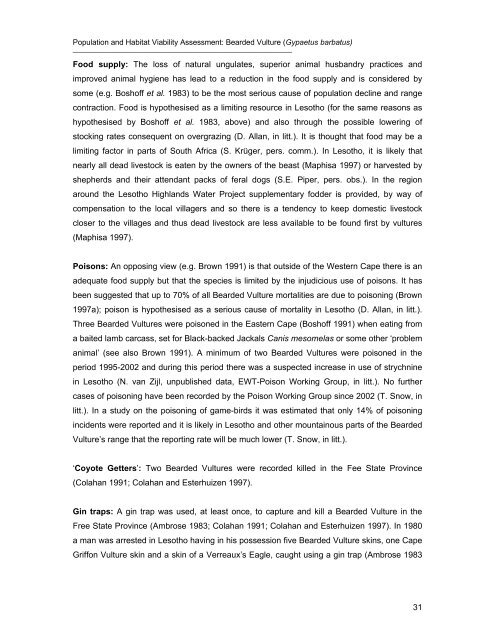BEARDED VULTURE POPULATION AND HABITAT VIABILITY ...
BEARDED VULTURE POPULATION AND HABITAT VIABILITY ...
BEARDED VULTURE POPULATION AND HABITAT VIABILITY ...
Create successful ePaper yourself
Turn your PDF publications into a flip-book with our unique Google optimized e-Paper software.
Population and Habitat Viability Assessment: Bearded Vulture (Gypaetus barbatus)<br />
________________________________________________<br />
Food supply: The loss of natural ungulates, superior animal husbandry practices and<br />
improved animal hygiene has lead to a reduction in the food supply and is considered by<br />
some (e.g. Boshoff et al. 1983) to be the most serious cause of population decline and range<br />
contraction. Food is hypothesised as a limiting resource in Lesotho (for the same reasons as<br />
hypothesised by Boshoff et al. 1983, above) and also through the possible lowering of<br />
stocking rates consequent on overgrazing (D. Allan, in litt.). It is thought that food may be a<br />
limiting factor in parts of South Africa (S. Krüger, pers. comm.). In Lesotho, it is likely that<br />
nearly all dead livestock is eaten by the owners of the beast (Maphisa 1997) or harvested by<br />
shepherds and their attendant packs of feral dogs (S.E. Piper, pers. obs.). In the region<br />
around the Lesotho Highlands Water Project supplementary fodder is provided, by way of<br />
compensation to the local villagers and so there is a tendency to keep domestic livestock<br />
closer to the villages and thus dead livestock are less available to be found first by vultures<br />
(Maphisa 1997).<br />
Poisons: An opposing view (e.g. Brown 1991) is that outside of the Western Cape there is an<br />
adequate food supply but that the species is limited by the injudicious use of poisons. It has<br />
been suggested that up to 70% of all Bearded Vulture mortalities are due to poisoning (Brown<br />
1997a); poison is hypothesised as a serious cause of mortality in Lesotho (D. Allan, in litt.).<br />
Three Bearded Vultures were poisoned in the Eastern Cape (Boshoff 1991) when eating from<br />
a baited lamb carcass, set for Black-backed Jackals Canis mesomelas or some other ‘problem<br />
animal’ (see also Brown 1991). A minimum of two Bearded Vultures were poisoned in the<br />
period 1995-2002 and during this period there was a suspected increase in use of strychnine<br />
in Lesotho (N. van Zijl, unpublished data, EWT-Poison Working Group, in litt.). No further<br />
cases of poisoning have been recorded by the Poison Working Group since 2002 (T. Snow, in<br />
litt.). In a study on the poisoning of game-birds it was estimated that only 14% of poisoning<br />
incidents were reported and it is likely in Lesotho and other mountainous parts of the Bearded<br />
Vulture’s range that the reporting rate will be much lower (T. Snow, in litt.).<br />
‘Coyote Getters’: Two Bearded Vultures were recorded killed in the Fee State Province<br />
(Colahan 1991; Colahan and Esterhuizen 1997).<br />
Gin traps: A gin trap was used, at least once, to capture and kill a Bearded Vulture in the<br />
Free State Province (Ambrose 1983; Colahan 1991; Colahan and Esterhuizen 1997). In 1980<br />
a man was arrested in Lesotho having in his possession five Bearded Vulture skins, one Cape<br />
Griffon Vulture skin and a skin of a Verreaux’s Eagle, caught using a gin trap (Ambrose 1983<br />
31


